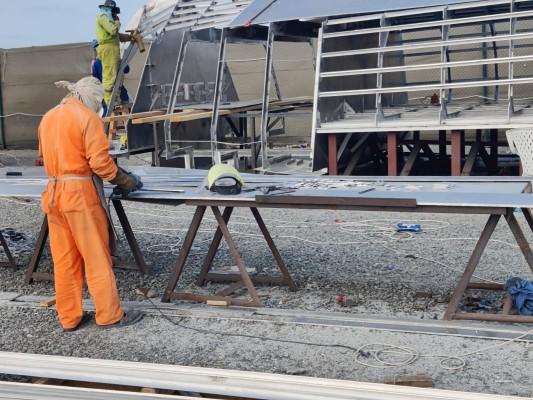Aluminium Barge Manufacturers: Driving Innovation in Marine Efficiency

Aluminium barge manufacturers are revolutionizing the marine sector by constructing lighter, stronger, and more efficient ships. Steel had ruled over barge building for decades, but increasing fuel prices and tougher environmental demands have paved the way for aluminium. Its light weight, high strength, and recyclability have made it the material of choice for contemporary fleets. Among industry players, VU Marine has emerged as a visionary operator, providing ships that are formulated to yield long-term value and operational effectiveness.
1. Lightweight Advantage and Fuel Economy
Aluminium's largest advantage that it contributes to barge building is weight savings. Aluminium weighs about a third as much as steel, so ships are much lighter. Lighter barges use less fuel, need smaller engines, and have the ability to haul heavier payloads in the same draft.
In reality, aluminium barges typically realize 20–30% savings in fuel over steel. As fuel represents a significant proportion of operating costs, this reduction increases profitability immediately while reducing emissions.
VU Marine is dedicated to designing barges to carry the most payload with the least amount of fuel—a more efficient journey with each voyage.
2. Corrosion Resistance and Durability
Saltwater and abrasive conditions can rapidly destroy steel barges. Aluminium, on the other hand, develops a protective oxide coating that naturally resists corrosion. This makes it less necessary to use expensive coatings and repairs, and enables ships to operate dependably for decades.
Operators generally experience maintenance costs lowered by as much as 40% with aluminium. This longevity is the reason aluminium barges tend to have higher resale values and longer lifespans than their steel equivalents.
VU Marine puts its focus on corrosion resistance in its designs so that operators have little downtime and maximum productivity.
3. Design Freedom and Accelerated Construction
Aluminium workability provides aluminium barge builders with more design freedom. It is simpler to cut, weld, and form compared to steel, so builders can design custom solutions like shallow-draft barges, modular units, or high-speed vessels.
Another important benefit is quicker construction. Aluminium barges can be finished 30–40% quicker than steel barges, assisting operators in adding capacity without delays of months. VU Marine employs modular approaches that reduce delivery schedules without neglecting bespoke requirements.
4. Sustainability and Environmental Benefits
Sustainability has become a defining factor in marine industries. Aluminium is fully recyclable, and recycling it requires far less energy than producing it from raw materials. Combined with lower fuel use, this makes aluminium barges significantly greener than steel alternatives.
For operators, investing in aluminium helps meet environmental regulations while cutting operating expenses. VU Marine’s vessels are designed with sustainability in mind, ensuring they remain future-ready as global standards tighten.
5. Longer Lifespan and Improved Resale Value
Since aluminium resists wear and corrosion, these barges have longer lifetimes. The operators make them last longer, while their resale values tend to be 15–25% higher than similar steel vessels.
While aluminium is more expensive in the front-end, the long-term finances—fuel conservation, reduced maintenance, and increased resale—make it the intelligent choice. VU Marine assures its barges return value not only in year one but over decades of operation.
6. Market Growth and Industry Outlook
Aluminium barge demand is increasing all over the world. The marine aluminium industry is expected to develop steadily at a growth rate of approximately 5–6% each year, paced by inland water shipping, offshore oil and gas, and environmental needs.
In the Middle East and elsewhere, aluminium is being used more by barge builder in UAE to supply ports, offshore facilities, and industrial shipping. Aluminium's strength, low weight, and resistance to corrosion make it a best-fit material for such demanding applications.
VU Marine's innovative products fit in with this growth as a go-to partner for industries adopting aluminium technology.
7. Innovation and Technology
The aluminium barge industry is transforming with technology. Modern technology like IoT sensors facilitates predictive maintenance, lowering downtime and expenses. Hybrid and electric propulsion systems are also being combined with aluminium designs to reduce emissions even more.
VU Marine combines such technologies into its barges so that clients experience the latest innovations while still benefiting from the tried and tested strength of aluminium.
8. Challenges and Overcoming Them
There are greater material and fabrication costs with aluminium but these are overcome by advantage. In the long term, operators spend less on fuel, upkeep, and resale than with lower-cost steelboats.
VU Marine deals with these challenges using cutting-edge manufacturing, expert teams, and design efficiency—all to enable clients to overcome initial obstacles while gaining long-term benefits.
Conclusion
Aluminium barges are not just a substitute for steel—they are the future of marine efficiency. They provide lighter weight, less fuel consumption, longevity, quicker building times, and environmental benefits that cannot be matched by any other material.
VU Marine is redefining the standard of new generation boats by integrating innovation, eco-friendliness, and efficiency. For operators looking to achieve long-term efficiency and dependability, selecting the perfect barge building company really matters—and VU Marine offers just that.
- Art
- Causes
- Crafts
- Dance
- Drinks
- Film
- Fitness
- Food
- Spiele
- Gardening
- Health
- Startseite
- Literature
- Music
- Networking
- Andere
- Party
- Religion
- Shopping
- Sports
- Theater
- Wellness




